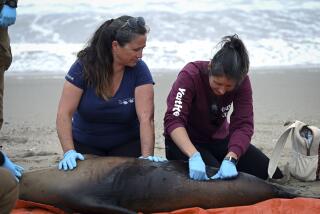The Eagle Has Landed on Channel Islands Fox
- Share via
It was the feather that proved it. The golden eagle shed the telltale bronze plume beside a pile of fur on the headlands of San Miguel Island.
For the past five years, scientists have watched helplessly as once robust populations of island foxes plummeted on the rugged chain of islands that comprise Channel Islands National Park. Now they have a pretty good idea what is causing their demise. The birds, soaring on long-distance air strikes from the mainland like great bombers, are turning baby foxes into eagle chow.
Bird attacks have long been suspected as contributing to the decline of island foxes. Golden eagles have been known to swoop down on feral pigs on Santa Cruz Island, and researchers figured every now and then one would snatch a fox for a side dish. But only recently did they discover just how hard the birds were whacking the foxes.
Under an experiment that commenced at the beginning of winter, biologists put dog collars fixed with radio transmitters on eight foxes, including seven pups, on San Miguel. Within several weeks, seven of the transmitters fell silent, a bad sign. Astonished, scientists discovered the carcasses of four pups and one adult female fox. All that was left were tufts of distinct gray and cinnamon fur.
Of the three remaining foxes, one died of a fur ball, another of an unknown cause and one is still alive.
“It was unexpected,” said park spokeswoman Carol Spears. “As a result of the radio collaring, we were able to ascertain golden eagles were responsible for nearly all of the pup mortality.”
The discovery goes a long way to explaining why so few pups have survived on San Miguel and Santa Cruz islands in recent years. Scientists have been mystified at the diminishing numbers of juvenile foxes each year. Pups are vital for long-term fox survival.
Whereas about 450 foxes were found on San Miguel five years ago, today just 30 or so remain. At that rate, island foxes, a threatened species in California, could be eliminated from the island by the end of the year. They are not faring much better on Santa Cruz or Santa Rosa islands either, though their numbers are holding steady on islands farther south, biologists say.
“The mortality of pups is very critical,” Spears said. “If pups are not surviving, we could very well lose the subspecies on those islands.”
Eagle attacks emerge as a serious threat now because other events have so depleted fox populations. Human activities on the Channel Islands over the last century have dramatically altered the islands’ rudimentary and sensitive ecosystem and contributed to the demise of foxes.
For example, domestic dogs that boaters bring ashore spread a parasite that clogs a fox’s heart with worms. Cattle grazing stripped away low-lying coastal sage scrub that foxes need for cover. Bald eagles, which eat fish and drive away golden eagles, were eradicated from the islands decades ago because of DDT poisoning. And the introduction of pigs in the 19th century enticed golden eagles to make the 30-mile flight from the mainland, said Kate Faulkner, chief of natural resources for Channel Islands National Park.
Not helping foxes is the fact that, unlike their mainland-based cousins, island foxes lived for centuries with no predators. Consequently, they adopted a risky behavior many small animals long ago eschewed--venturing out in the daylight.
“The ecosystem is out of whack,” Faulkner said. “It doesn’t appear golden eagles occurred on the islands in the past. There is no indication the foxes evolved with predators. Because they are out during the day and golden eagles are daytime hunters, predators can get them.”
An island fox is no match for a golden eagle. Though they are the largest land mammals on the islands, adult island foxes are about the size of a cat, smaller than those found on the mainland. In contrast, golden eagles are veritable B-52s; with 6-foot wingspans, they are the largest eagle in North America.
Island foxes inhabit six Channel Islands, including Santa Catalina, San Clemente and San Nicolas, and are a separate species from foxes found on the mainland. Further, each island has a separate subspecies of fox. Their remains have been found in Chumash Indian graves, suggesting they may have been kept as prehistoric pets.
Confronted with a crisis, the National Park Service is considering drastic action to halt the decline of island foxes on the islands in the Santa Barbara Channel. A team of wildlife experts will convene at the Ventura headquarters of Channel Islands National Park April 20-22 to compare notes and devise strategies to save the park’s foxes.
Some possible solutions call for launching a captive breeding program to replenish fox populations in the wild. It may be time to approach the federal government and seek protection under the Federal Endangered Species Act. The U.S. Fish & Wildlife Service may be asked to get involved to relocate bald eagles to the islands to check golden eagles, Spears said.
“It’s a complex problem and it’s going to be difficult to address,” Spears said.
More to Read
Sign up for Essential California
The most important California stories and recommendations in your inbox every morning.
You may occasionally receive promotional content from the Los Angeles Times.













